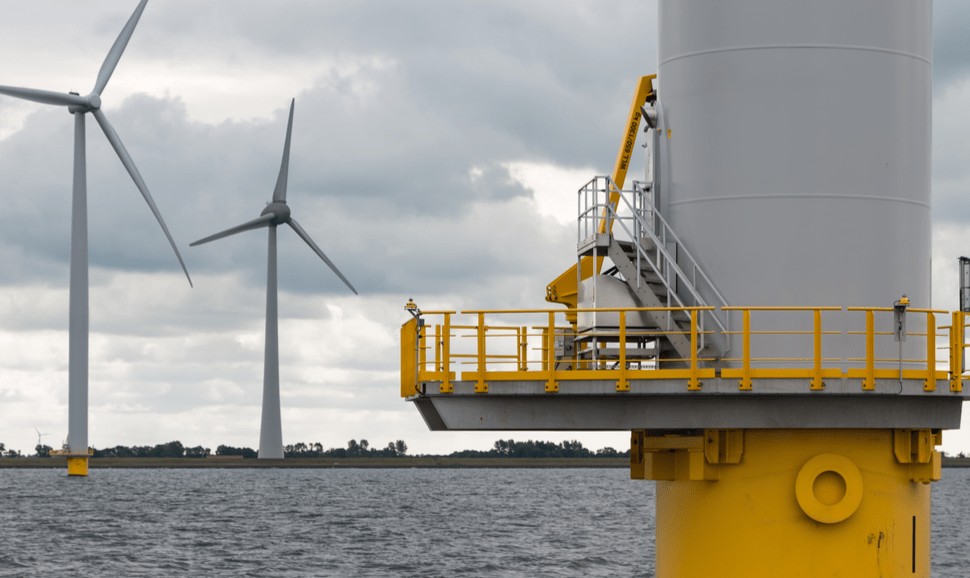Could wind power offshore soon prove cheaper than on land?
The plummeting costs of offshore wind plus strict onshore planning rules are blowing in this direction in the U.K., a new report says. Read More

Onshore wind is thought to be the cheapest form of new generating capacity available in the United Kingdom, but could its crown soon be challenged by its offshore cousin?
That is the question posed by a new analysis by influential energy research specialist Cornwall Insight, which suggests offshore wind is likely to surpass onshore wind power to become the new cheapest source of new energy in less than 10 years.
The assumption long has been that the costs associated with installing and maintaining turbines at sea will continue to more than offset the higher yields enjoyed as a result of stronger and more reliable winds, meaning onshore wind farms would continue to offer the more cost effective option.
However, Cornwall Insight’s new projections suggest the emergence of a new generation of giant offshore wind turbines coupled with ongoing planning restrictions for onshore turbines could see offshore projects undercut their onshore equivalent on a levelized cost of energy (LCOE) basis by around 2028.
The company said the projections are based on projected capital costs by technology, fixed and variable operational costs, expected hurdle rates and locational factors such as transmission losses and connection fees. It also uses the current load factors for both technologies, which stand at 58.4 percent for offshore wind and 38 percent for onshore wind.
“The renewable energy market is under a process of transition with onshore wind facing the real prospect of being usurped by its offshore cousin to be the cheapest source of clean power in the not so distance future,” said Tom Edwards, senior modeller at Cornwall Insight. “Improvements in offshore technology are occurring all the time and for offshore wind, increasing the size of turbines is making a significant impact with 8MW models currently being deployed, and larger 10MW and 12MW models under development as the technology advances. With these larger economies of scale, it is inevitable that costs will fall.”
The report comes just days after Siemens Gamesa became the latest offshore wind turbine developer to unveil plans for a giant 10MW turbine, which promises to slash costs and improve yields for developers.
It also comes ahead of the government’s next clean energy auction later this spring, expected to see developers table bids below the ceiling price of $68/MWh in 2012 prices, moving the sector closer to the LCOE promised by new onshore wind developments.
A separate report from energy consultancy Wood Mackenzie suggested global offshore wind power demand will increase almost sixfold over the coming decade as costs continue to fall and new markets open up. The study predicts average LCOE in Europe will halve between 2018 and 2027 as competition intensifies, turbines increase in size and economies of scale improve. “CAPEX and OPEX across Europe will drop, on average, by 36 percent and 55 percent respectively by 2027,” said Shimeng Yang, report author and European offshore analyst.
However, while the reports highlighted the growing competitiveness of offshore wind, the Cornwall Insights analysis also underscores the ongoing challenges faced by U.K. onshore wind developers still locked out from competing for government-backed clean energy contracts, despite the fact it is widely thought they could table bids well below current wholesale prices.
The government is hoping that onshore wind projects will start to come forward without government-backed contracts, known as contract for difference (CfD), and instead will take advantage of Power Purchase Agreements (PPA) or private wire links with corporate energy users, or look to see power directly on the wholesale market on a merchant basis.
A report last month in the Sunday Telegraph suggested the government was considering such an approach for the HS2 high speed rail line, highlighting a report last year which explored how PPAs or private wire links to renewables projects would provide much of the power required by the huge infrastructure project.
The Sunday Telegraph report raised the prospect of swathes of turbines lining the HS2 line — a scenario immediately mocked by wind industry experts who pointed out the need to secure planning permission and locate new projects in areas with the best wind resource made such an outcome near impossible. Writing on Twitter, Carbon Brief deputy editor Simon Evans also noted that the Sunday Telegraph drew on a document from consultancy KMPG which suggested the use of renewable power contracts by HS2 could cut the cost of the power it will use.
However, while a growing number of corporates are looking at using PPAs to secure access to cost effective wind power projects, industry groups maintain that for a significant number of new developments to move forward, it requires the government to let projects compete for CfDs. Meanwhile, hopes developers could take advantage of the merchant market are being stymied by planning rules that limit the size of turbines that can be used for onshore wind farms.
Michael Parker, head of business development in Europe for Innogy’s onshore wind business, argued that for onshore projects to cut costs to a level where they could compete in the merchant market without the security of long term contracts, larger turbines would be needed than the 410 feet that appears to be the defacto limit for new projects in the United Kingdom.
“That’s the balance — which is it that people want?” he said. “Do they want subsidies or do they want increased tip [height]? Because merchant projects are undoubtedly possible in the U.K. because of the wind resource we have. What we need to do now, though, is increase that tip height.”
His comments were echoed by Edwards at Cornwall Insight, who said an analysis by the Onshore Wind Cost Reduction Taskforce found that LCOE savings of between $5/MWh and $9/MWh were possible with tip height and rotor diameter optimisation for onshore wind. “The latest turbine specifications claim to improve load factors by as much as 26 percent,” he added. “While restrictions on onshore wind turbine height are maintained, projects will be unable to take advantage of these improvements to reduce costs. For onshore wind to keep pace with its offshore counterpart, planning decisions will need to be relaxed.”
He also argued there was a compelling rationale for loosening planning restrictions. “This will not only benefit consumers with cheaper cleaner energy but help the government towards its decarbonization targets, not only in terms of facilitating the best conditions for new build onshore wind but also allowing existing sites to be repowered optimally,” he explained.
But with the government excited at the prospect of low cost offshore wind and media outlets still running scare stories about the extremely unlikely prospect of turbines marching across Middle England, can ministers be convinced to give onshore developers a boost? Providing a smoother route to market for onshore wind developers may make sense from an economic and decarbonization perspective, it may even save billpayers money and improve U.K. energy security, but much of the Conservative Party faithful remains resistant to the idea regardless of the benefits.

Subscribe to Trellis Briefing
Featured Reports

The Premier Event for Sustainable Business Leaders















